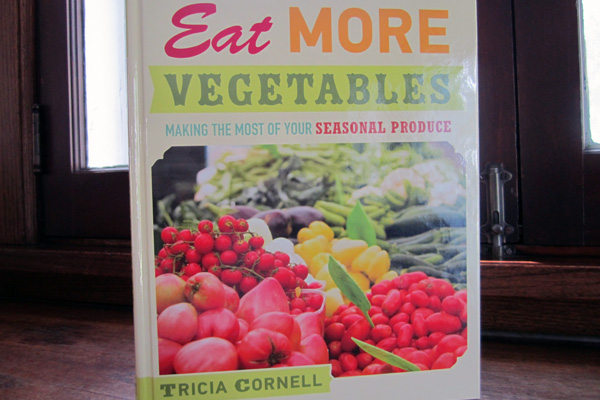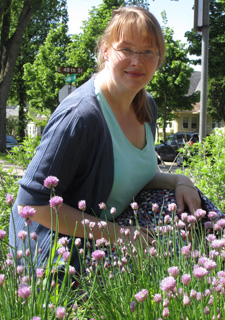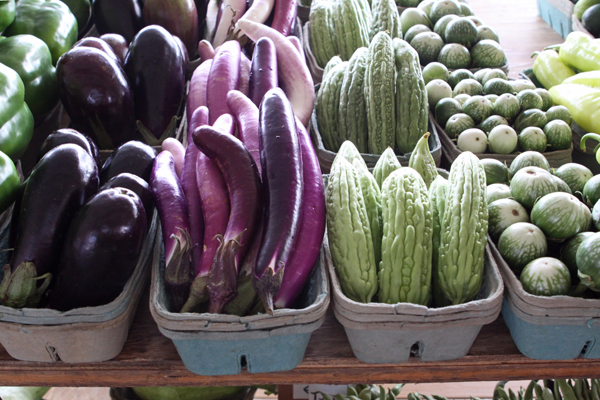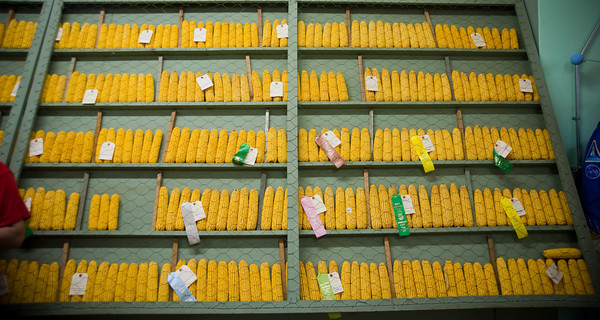
Tricia Cornell (below) does not want you to feel judged by the cover of her new cookbook, Eat More Vegetables: Making the Most of Your Seasonal Produce ($27.95, 202 pages). After all, she’s not a die-hard locavore or a paragon of health: She eats meat, fried food, and avocados with gusto. There are even some vegetables she buys — gasp — frozen. Her family doesn’t eat every vegetable and neither should you – just the ones you like.
“I just say the name of the book and people say, ‘Oh yeah, I don’t eat enough vegetables,’” says Cornell, a contributing writer for The Heavy Table. “No judgment: It’s just this brings my family joy; maybe it could bring other families joy. And, you know, if you don’t like beets, eat something else. Beets taste like dirt to some people — I get that.”

So if it’s not cajoling you to eat your spinach, what is this book about? It’s about getting through more vegetables, so you’re not wasting all those beautiful goodies that came home from the CSA, farmers market, and grocery store. “My title for the book was ‘Vegetables: A Love Story,’ and the [Minnesota Historical Society] Press wisely said you need something more straightforward,” Cornell says, “but that’s really what it was: the change from ‘oh, those damn vegetables are rotting in my crisper’ to ‘I am so glad to see these vegetables.’”
Nine years ago, overwhelmed by a spoiled collection of limp lettuce heads, sprouting onions, and suspiciously soft squashes, Cornell nearly gave up on her CSA half share. Instead, she made a resolution to persevere through better planning, and she now has a collection of recipes and the vegetable handling skills to comfortably cook her way through every CSA box. “I don’t want to pretend that it’s not work, just that it’s worth it,” she says. “We get into ruts that really cut down on the varieties of the foods we eat, so putting in a little more work to wash up the lettuce or trim the asparagus is worth it.”
In that spirit, Cornell has written a book aimed not at the folks who don’t eat vegetables, but those who are already sold on the concept, who like cooking and are open to trying whatever the farmer — be it through a CSA, farmers market, co-op, or grocery store — throws at them. Eat More Vegetables combines recipes and menu plans with tips for washing, storing, freezing, and putting up your vegetables, plus a few favorite tools.
Of note, Cornell is nutty for her microplane grater, and swears a low price point belies its extraordinary usefulness. “I realized that not everyone loves them as much as I do when I sent a couple of the book’s recipes to my sister to test, and she said, ‘What the hell is this thing?’” says Cornell. “So I sent her one. Now she too loves her microplane. Cheese melts better when you grind it finely, and I hate garlic presses — I’ve never found one that works.” Hear, hear!

She also stands by the importance of using a good olive oil and vinegar. Her current favorites are a California extra-virgin olive oil, full of fruit and pepper flavors, and mild golden balsamic vinegar, both of which she buys at Vinaigrette in South Minneapolis. “It’s expensive but if you use just a little bit to finish dishes or toss on your salad, you’re going to enjoy that salad so much more than if you had used cheap olive or canola oil,” Cornell says. “The point is that it should be something you like so much that you can’t wait to eat it on your salad. I’m kind of evangelical about bottled salad dressings; I don’t get them at all. They all taste clumpy because they are thickened with gelatin or worse. You just need some good olive oil.”
On that note, we tried a recipe for Honey-Lemon Vinaigrette in the spring section of Eat More Vegetables. Combining honey, lemon juice, and olive oil in equal parts with a good amount of garlic (grated on a microplane, which does work remarkably well, thank you), the dressing gave our spring greens the expected sweet-tart flavor, but also the unexpected zip of the garlic’s spicy hot side.

Although you don’t have to have a CSA share to enjoy the cookbook, one of the beauties of Cornell’s effort is that there are multiple recipes for many of the veggies that show up in a typical box. Greens are used fresh in salads, pickled in bibimbap, baked in casseroles, and wrapped around savory meats. Similarly, we sampled Cornell’s recipes for a fresh Hakurei Turnip Slaw and Speedy Sauteed Hakurei Turnips and Greens. Crisp, mild, and vaguely radish-like, the vegetable was delicious in both recipes, and nearly unrecognizable between them — a bonus if you are going to eat turnips twice a week or so.
As a home cook rather than a professional chef, Cornell initially drew on the recipes she makes most often at home. “I sat down, thought about what we eat during the summers, and came up with about 75 recipes. Obviously, there are 125 in the book so, for the rest, I went back to memories of things from childhood or traveling,” she says. “I asked my grandmother for recipes. Of course, grandmothers are no help at all because they say things like, ‘Bake until done.’”
For example, there is the recipe for Salt Potatoes. “She’s from Upstate New York, where apparently this is a thing. I did manage to get the recipe from her, but then she remembered the ratio of salt to water and said, ‘Nobody eats those anymore; that’s terrible for you.'”
Cornell spent some time, after college, working as a travel writer in Estonia and Lithuania, and some of her favorites from that time have made it into the book as well. “So there’s this cold soup, made with the first beets of the summer, called Šaltibaršciai,” she says. “I really worked to match what I remembered eating in the outdoor cafes on those hot summer days in Lithuania. Of course, Lithuanians will write in and say, ‘No, you didn’t get it,’ but that’s okay.”

Although cold beet soup might sound exotic, Cornell is adamant that Eat More Vegetables is as kid friendly as any cookbook out there. She mentions that at book signings parents will often pick up the book and then set it down again, saying they’re disappointed there aren’t more kid recipes. “I want to say, ‘That’s what my kids eat!’”
Cornell’s approach has been to put a variety of veggies on the table and eat them; eventually her kids will eat them, too. Her son and daughter have favorites: snap peas, cauliflower, and asparagus. Plus “early in summer, a fresh head of lettuce, when it’s so tender,” she says. “No one can resist that.”
And the kids continually grow into new vegetables. “There’s a grilled zucchini recipe in the book that is one of my favorite things, especially in the summer when the little, tender zucchinis are so good,” she says. “I always put a little tiny bit on my son’s plate, and I don’t care whether he eats it or not, but I put it on his plate because I made it. One day he finally put the darn zucchini in his mouth, and he ate the rest of my zucchini – as in, I didn’t get any more of it.”

Most of Cornell’s recipes are simple fare, the kind of food you can make on a weeknight without losing your mind or using every pot in the house. Although the following corn pudding recipe comes from the high summer section of Eat More Vegetables, we found early Minnesota corn at the co-op and decided to give it a whirl. It is one of the fussier recipes in the book, but well worth separating eggs and getting out the hand mixer.
When we ask Cornell about the recipe, she harks back to another grandmother and a lost recipe. “I had to go through a lot of cookbooks, trying to find something that I could cobble together to create a recipe that was the most like what I remembered,” she says. “Poor Grandma: I didn’t quite get there. It’s a nice casserole, but it’s not as creamy as hers. It was so custardy.”
That may be so, but we found that this recipe renders a deliciously salty corn soufflé — and that it left us far from wistful.

Corn Pudding
From Eat More Vegetables by Tricia Cornell
(Serves 4)
2 tbsp butter
½ medium onion, minced
1 tsp kosher salt
½ jalapeno pepper, seeds and ribs removed, thinly sliced (optional)
3 cups corn kernels (about 3 ears)
4 eggs, separated
½ cup grated cheese (2 ounces; fontina is a good choice)
Heat oven to 350 degrees. Grease a 1.5-quart soufflé pan or other deep baking dish. Melt butter in saucepan over medium heat. Soften onions in butter, with salt, about 5 minutes. Do not brown. Add jalapeno if using, and cook until fragrant, about 1 minute. Stir in kernels. Remove from heat and let cool to room temperature.
Beat egg whites to stiff peaks. In a separate bowl, beat egg yolks until smooth. Stir cooled corn mixture and cheese into egg yolks. Fold in beaten egg whites. Slide into prepared pan. Bake 45 minutes, until firmly set and barely golden brown on top. A toothpick will not come out clean, but the top should not jiggle.


This book sits on my counter, not as an admonishment, but as a reminder of how simple it is to prepare delicious vegetable dishes. If we consider veggies something to be hidden or try to sneak them in where they can’t really shine (Kale Brownies, anyone?), then of course it’s hard to get kids to eat them. If you follow Tricia’s simple recipes, you’ll soon find that you and your kids are both enjoying vegetables more.